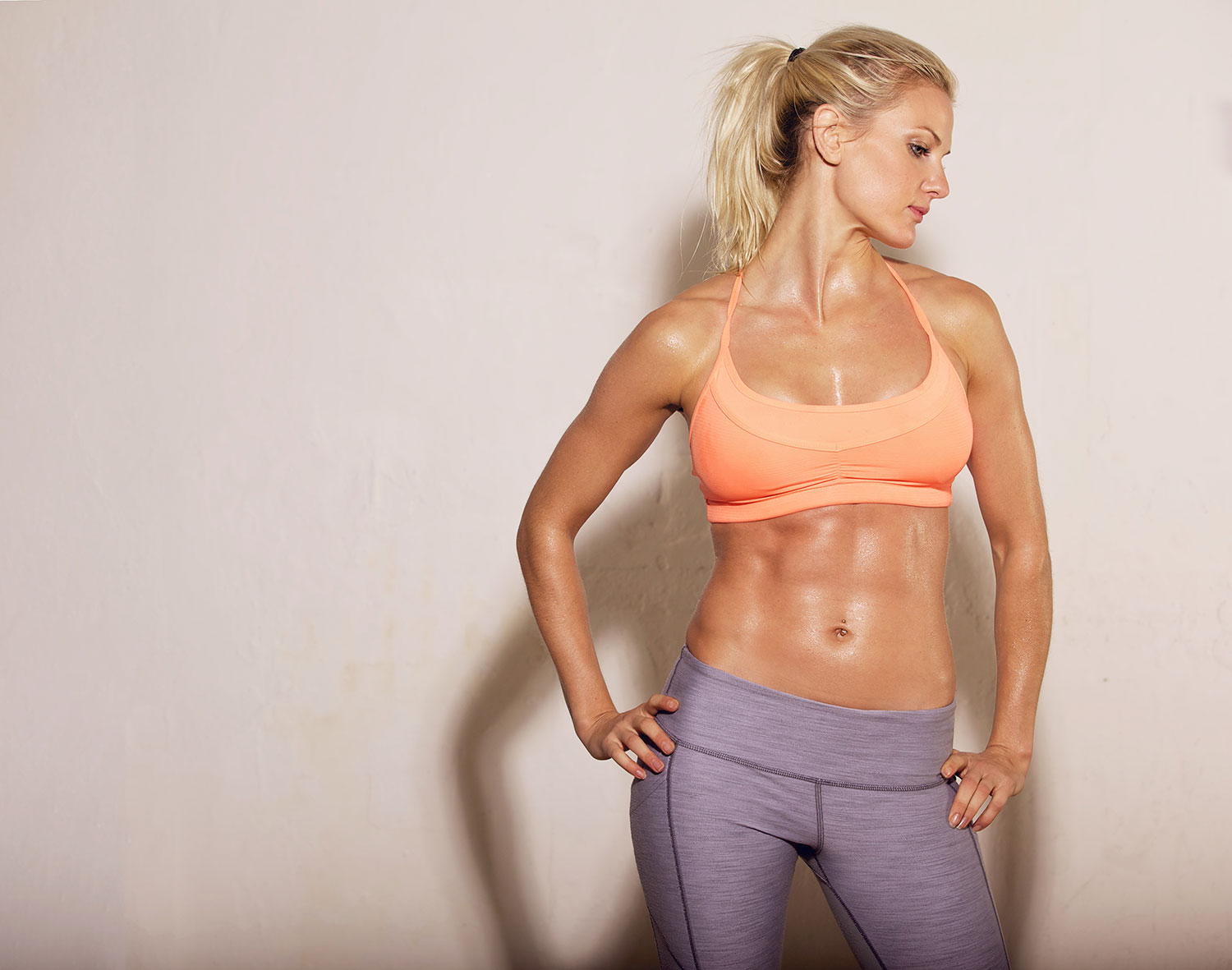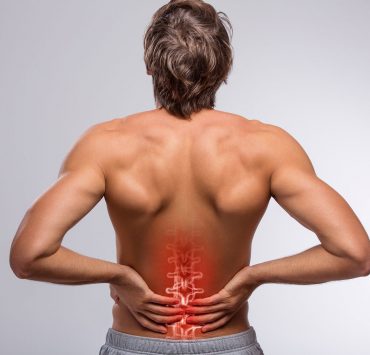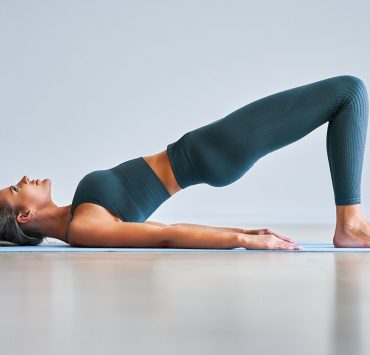
Rose graduated with a degree in Anthropology, which takes her…
Many people dream of having a “six pack” and toned abs – but is this achievable with yoga? First of all, it is important to know that a six pack is only a small part of what strong and healthy abdominal muscles entail. In fact, a six pack is just part of a surface muscle (the rectus abominus), and does not necessarily signify a strong core. But while yoga may not necessarily lead to a six pack, it can still be incredibly helpful in building core strength. This is because yoga focuses on bodyweight exercises, and engaging the bandhas, or deep energy centers. Poses such as arm balances or inversions require deep core strength as the yogi learns to support their entire body through their center. If you are looking to build core strength and abdominal muscles with yoga, take a moment to learn the anatomy and benefits of the core. From there, you can delve into specific yoga poses that will enable you to get the abdominals you want.
Anatomy Of The Core Muscles

To understand the core of your body, it can be useful to imagine the word “core” as we know it in other senses. For instance, the core of an apple is its deepest, firmest, most internal structure. It connects the stem with the bottom of the fruit. It is connected to the entirety of the apple flesh that wraps around it. The human body’s “core” acts in much the same way. The core, or abdominal muscles, are located at the mid point and center of the body, and form to connection between most other structures.
A photographer gets people to pose for him. A yoga instructor gets people to pose for themselves. T. Guillemets
The core is composed of multiple muscles, rather than one big muscle as is often thought. The muscles range from superficial muscles that are closer to the skin (such as the rectus abdominus, which can give the tell tale “six pack” look), to deep muscles located further within the body (such as the transverse abdominus, which is important in inversions). The muscles that make up the core include the rectus abdominus, oblique abdominals, iliopsoas, erector spinae, pelvic floor muscles, deep gluteal muscles, and quadratus lumborum. Each muscle serves a unique purpose and action, based on its origin and insertion. Some such as the erector spinae, are located on the posterior (back) of the body and run along the spine. Others, such as the iliopsoas, run from the back down through the pelvis to the thigh bone, connecting the core to the leg. As becomes apparent, the core is a complex set of muscles that interact not only with each other, but can also impact the organs, spine, limbs, and more.
Benefits Of Strong Core Muscles

There are myriad benefits to having strong core muscles – and these go beyond any superficial or ego-driven desire based on physical appearance. A strong core can improve posture, reduce back pain and in particular low back pain, and improve overall body stability. In turn this can lead to increased ease in performing every day tasks, such as cleaning, driving, reaching, dressing, carrying, bending, and more. A strong core also supports the internal organs and can aid digestion, detoxification, and even breathing. Additionally, because the core is connected to the legs via the psoas muscles, it particularly helps with ease in walking, running, standing, or any upright tasks. It has been found that a well balanced core muscle system, in which all the various muscles are equally strong and healthy, leads to spinal stability. This in turn enables a person to have a firm support for any movement they may try. As such, it is easy to see why having a strong core is so important to overall health and vitality.
7 Yoga Poses For Abs
The following seven poses are classic yoga poses, each of which can help build core strength and definition in the abdominal muscles. Whether your goals are aesthetic, postural, internal, stabilizing, or more, it is likely that nearly everyone could benefit from core strengthening. Try these poses in combination with a regular yoga practice and notice the benefits.
Phalakasana — Plank Pose

To practice plank pose, place both hands firmly at the front of the mat. The fingers are pointing forwards and the crease of the wrists is parallel with the front of the mat. Ground into all four corners of the palm evenly. The hands should be planted beneath the shoulders, with arms strong and straight. Tuck the toes and plant the feet at the back of the mat. Feet should be about frontal hips width apart, and the body should be extended in one straight, strong line. The crown of the head reaches toward the front of the room. Think of lifting up and out between the shoulder blades, rather than sinking down into the pose. The tailbone is level and reaches toward the back of the room. To keep the core strong in this pose, think of engaging the core and lifting the navel up toward the spine. The longer you hold plank pose, the more heat you will feel building in the body, and the more you will be challenging your core strength. If you need to modify the pose, you can bring your knees down to the mat.
Makara Adho Mukha Svanasana — Dolphin Plank Pose

Dolphin plank pose is very similar to the previously described plank pose. The major difference is that instead of grounding into the hands, the yogi plants their forearms onto the mat. In this pose, the elbows are aligned with the shoulders, and the forearms and palms firmly plant into the mat. Make sure to continue lifting between the shoulder blades, and to keep the bottom level and the tailbone reaching toward the back of the room. Make a conscious effort to engage the core by lifting the navel up and in, and maintaining a straight line through the torso. Likewise with plank pose, dolphin plank pose offers more challenge the longer it is held. Aim to hold it for a minimum of five breaths, and increase the time held each time you practice it.
Vasisthasana — Side Plank Pose

To practice side plank pose, or vashistasana, start in plank pose. Shift your weight into your right hand, and shift onto the side of your right foot. Stack your left foot on top of your right foot. Stack your left hip on top of your right hip. On an inhale, reach your left arm up toward the ceiling, with the palm open toward the left side of the room. The body should all be on one plane. Engage the core here by keeping the hips level and avoiding dumping into them. This pose is incredible for strengthening the core, and is especially useful as it focuses on the oblique abdominal muscles. These are the abdominal muscles that run along your side body, instead of straight down the front. They are very important for general core strength, as well as for twisting movements. Aim to hold side plank pose for as long as you can, or minimum of five breaths, before repeating it on the other side.
Virabhadrasana III — Warrior III Pose

For Warrior III, or virabhadrasana III, start standing at the top of your mat with your feet together and your hips facing forward. Inhale and reach your arms straight up in the air, keeping the palms facing each other and the shoulders relaxed down the back. Exhale and, shifting your weight into your right leg, lean the torso forward whilst lifting the left leg straight back. Let your top body counter balance your left leg in a straight line. In full posture, you should be in a “T” shape, with your torso and left leg in a straight line balanced over the supporting right leg. Maintain a neutral balance in your hips, dropping your left hip down level with your right. To maintain balance in this pose, the stabilizing muscles in the core must be engaged. This requires strength in both the superficial muscles like the obliques, as well as deeper muscles like the transverse abdominus and psoas that act on the core, spine, and legs. Maintain Warrior III for a minimum of five breaths, before repeating it on the other side.
Navasana — Boat Pose

To get into boat pose, or navasana, start by sitting in the middle of your mat. Bend your knees and plant your feet hips width apart, just a foot in front of your groins. Reach your arms straight out in front, keeping the palms facing each other. Before lifting into the full pose, find your balance on your bottom. You should be sitting with pressure right in between the sacrum (bottom of the tailbone) and sits bones (tuberosities from the pelvis). By maintaining your base between these bony structures, you will ensure that your core remains active and engaged in the pose, rather than letting you rely on leaning back on your tailbone. From here, first lift onto your tip toes, beginning to engage the low belly and deep core muscles. On an inhale, lift the feet off the mat. In full posture, your legs will be extended straight up in a 45 degree angle, and your arms are lifting straight overhead, making a “V” shape with your body. However, this can be very challenging, particularly if you are just starting out on your journey to core strength. The important thing is to maintain alignment in this posture to ensure you are really working your core muscles. Choose any modification along the way to full posture and hold it as long as you can.
Ardha Chandrasana — Half Moon Pose

You can transition into half moon pose, or ardha chandrasana, from warrior III. However, it does require a certain level of balance so feel free to use blocks, a wall, or other props to assist you in this transition. From warrior III on the right leg, open your body toward the left side of the room. Stack your left hip on top of your right hip. Inhale and reach the left arm toward the ceiling, whilst letting the right arm reach toward the mat. Your right hand can float a few inches above the mat, or alternatively find balance by touching the mat or using a block as support. In half moon pose, the body is all on one flat plane. To maintain the straight torso in this pose, particularly when relying solely on balance rather than a block, requires intense core strength. Think of engaging the core and bringing the muscles in and up. Engage your side abdominals, or oblique muscles, to help support your extended torso in this pose.
Utkatasana — Chair Pose

Chair pose, or utkatasana, is a primary yoga pose that is practiced during sun salutation B. To practice chair pose, begin by standing on your mat with your feet together. Inhale the arms straight up in the air, keeping the palms facing each other. Exhale and bend the knees, sitting the bottom back into the pose. Maintain a straight spine, letting the shoulders relax down the back, like you are sitting back in a chair. To maintain alignment and keep the pose working your quadriceps, gluteals, and abdominals, make sure your knees don’t go beyond your toes. Breathe through the pose and bring your lower belly up and in. Chair pose is often remembered for its affect on the thigh muscles, or quadriceps. It does help build quadriceps strength, but it also draws on core strength as well. To maintain the pose, especially when the arms are lifted, calls on the core muscles that connect to the spine (such as the erector spinae) and the legs (psoas, iliopsoas, and quadratus lumborum). Engaging your core in this pose will even relieve some of the pressure on other muscle groups, like the legs, and help you maintain the pose for longer.
Conclusion
Each of the previous poses helps build core strength through a different mechanism. Whether it draws on the stability necessary for balance, such as Half Moon Pose, or is focused on the superficial abdominal muscles, such as in boat pose, each posture is a valuable addition to any yoga practice. Building a strong core will have positive influences across all areas of your life, and will even make your yoga practice easier and more achievable.
What's Your Reaction?
Rose graduated with a degree in Anthropology, which takes her understanding of basic human needs to a whole new level. Her intelligence and passion for healthy living is reflected in her written work.














